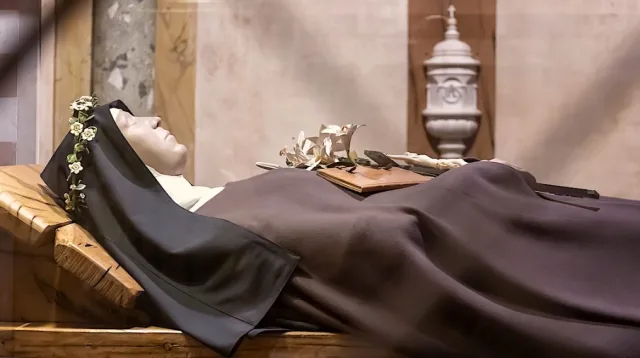 St. Clare of Assissi:
St. Clare of Assissi:
QUICK FACTS ABOUT ST. CLARE:
-
- She was born in Assisi, Italy, in 1194 to a wealthy family. Her father was a cloth merchant and her mother was a devout Catholic.
- She was greatly inspired by the example of St. Francis of Assisi to give up her wealth and possessions to live a life of poverty and service to others.
- In 1212, Clare secretly left her home and family to join St. Francis and his followers. She was initially refused entry into the order, but St. Francis eventually relented and allowed her to join.
- She founded the Order of Poor Clares in 1212, a religious order for women dedicated to following the teachings of St. Francis.
- She wrote a rule for the order that emphasized poverty, simplicity, and obedience.
- She was a gifted mystic and had a close relationship with God. She often experienced visions and ecstasies. She also had a gift for healing the sick and the dying.
- Just two days before Clare of Assisi died, Pope Innocent IV’s papal bull, Solet annuere, written August 9, 1253, confirmed that Clare’s rule would serve as the governing rule for her community of Poor Ladies at San Damiano.
- Two days later, Clare died at the age of 59. Her remains were interred at the chapel of San Giorgio (where St. Francis’s remains had initially lain) while an adjacent basilica to hold her relics was being constructed. It was eventually relocated to her own chapel.
- She was canonized as a saint in 1255.
- For roughly six centuries, the body of St. Clare lay buried deep under the high altar of her basilica.
- in 1850, Pope Pius IX granted permission that excavations be made to search for the body of Clare.
- the stone coffin containing her body was found. When it was opened, it was discovered that St. Clare’s body, though blackened with age, was still incorrupt. She was buried with her poor tunic in addition to the rule that she had written.
- Her remains were put into a crystal coffin, which was placed in a newly constructed crypt (completed in 1872) within the basilica. The feast of the Finding of the Body of St. Clare, which was instituted by Pope Pius IX, is celebrated by the Franciscans and Conventuals, as well as the Poor Clares.

- In time, Saint Clare's remains began to deteriorate; thus, a mask was constructed to cover her remains, which were soon reduced to bones. The mask can be seen by the public today, while her actual relics can be seen only by the sisters who have access to the rear of the crypt.

